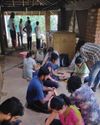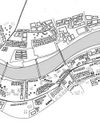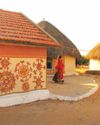The following essay critically reflects on the morphogenesis of architecture in the South Asian territories while debating and positioning on the role of the architect in shaping our built environment. It builds its premise on readings such as Correa’s ‘Change and Continuity’, Raj Rewal and Romila Thapar’s ‘Tradition and Change’, Yatin Pandya’s ‘Contemporary Indian Architecture’ and ‘Courtyard houses of India’ etc.

Much like the city is a collection of socio-cultural landscapes of people and place, emotion and expression and time and travel, the nation is an agglomeration of urban and rural systems seen through the alchemy of time and space. Place in its geographical and climatic milieu and society in its socio-cultural fabric, forms the mix through which one analyses the spirit of decisions, evolutions and impacts. The numerous filters of people, culture, religion, activity and history form multiple overlays of South Asia’s multidimensional overtones.
As architects, we often reflect on the environs in which we have evolved, developed and called ourselves citizens. The metamorphosis of any societal system from barbarian to tribal to democratic has been non linear and shaped by the dualities of traditional and modern, change and continuity, local and global coupled with the underpinnings of politics, power and economics. In the histories of a people and their experiences of a combined past, lie the tiniest nuances of pause, reflection and erudition. It is these gaps in time, that have brought change, whether appropriate or inappropriate and it is these discontinuities of life – in general and in generations – that pose one of the important challenges to an architect, where there lies the power to transform the socio-cultural landscape of a country and its architectural manifestations for the g-local scenarios.
Here, the role of an architect as a creator of built (and unbuilt) expression, as a sculptor of sustainable and humane living environments and as an interpreter deciphering human values comes into place.
South Asia: The breeding ground for ethnicities, geographies, territories and religions
Bu hikaye Indian Architect & Builder dergisinin January 2019 sayısından alınmıştır.
Start your 7-day Magzter GOLD free trial to access thousands of curated premium stories, and 9,000+ magazines and newspapers.
Already a subscriber ? Giriş Yap
Bu hikaye Indian Architect & Builder dergisinin January 2019 sayısından alınmıştır.
Start your 7-day Magzter GOLD free trial to access thousands of curated premium stories, and 9,000+ magazines and newspapers.
Already a subscriber? Giriş Yap

Interlacing Perspectives
‘Meraki-2019’ A visionary Seminar series presented by Dr.Baliram Hiray College of Architecture, Bandra(East), Mumbai.

Facilitating A Community Through Architectural Practice
The humble, self-designed, self-built and organically planned home built by the majority of the world population rarely gets appreciated and critiqued as a viable lesson in architectural design.

The Art Of Solving Problems Creatively
The practice of architecture is perhaps incomplete without the complement of a variety of other arts.

Upcycling towards a playful tomorrow
Play is like the middle child, often forgotten, and always taking a back seat. For young kids, play can simply be running around, armwrestling with friends, building sandcastles on the beach, or singing popular music tracks in the shower.

Balancing The Poetics And Pragmatism Of Everyday Design
Humanity is faced with an oxymoronic crisis. The crisis involves the earth, the environment, impending looms of climate change, deforestation, loss of species, dwindling resources etc.

Just Give Me Some Space: Discussions And Beyond
Just Give Me Some Space (JGMSS) is Suha Riyaz Khopatkar’s debut book that paints a portrait of the dynamic life of an architecture student.

The Next In Vernacular Architecture
Architecture has become a capitalist.

Rethinking The Future: Architecture And Its Education
“I want to be like animals, the bird makes a nest in one or two days, the rat digs a hole in a night, but intelligent humans like us spend 30 years to have a house, that’s wrong.” - Jon Jandai

Uniting The Human-Scale With The City-Scale
London-based architect Usman Haque is famed for his interactive architectural systems, and for his exploration of newer, more effective ways of creating human engagement and interaction through his designs. Indian Architect & Builder caught up with him, to quiz him on a variety of topics such as his journey as an architect, his inspirations and philosophies, architects using the digital revolution to their advantage, and more!

Framing spaces
Almost every architect also doubles as a photographer or at least an enthusiast.